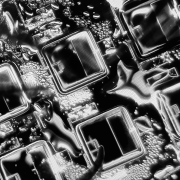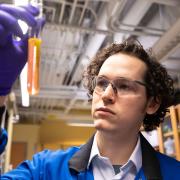Chemist Sarah King studies the broken places. “The regions where two materials join together, where there are defects, where there are dangling bonds,” she says. “Often these things can really determine how a material behaves as a whole.”
King, an assistant professor of chemistry at the University of Chicago, was recognized Feb. 9 as a Cottrell Scholar. The award, given by the philanthropic Research Corporation for Science Advancement, honors “outstanding teacher-scholars who are recognized by their scientific communities for the quality and innovation of their research programs and their academic leadership skills.”
The award will further King’s research. “We want to think about how to make a material from the ground up,” she says, “and to make what we want, we have to understand its interactions.”
It will also support her interest in fostering young scientists, from high school all the way through postdoctoral researchers.
Breaks and behavior
A huge part of research is dedicated to coming up with ideas for new kinds of materials. For every new-and-improved iPhone camera, there was a breakthrough where someone figured out how to cram more sensors into the thin wafer inside the phone. For every solar panel, someone had to figure out a way to seed atoms into silicon to collect and channel electricity. And so on.
King’s goal is to make it easier and faster for scientists to find new materials when they have a specific need. This can be accomplished by building a greater understanding of the rules that govern these materials’ properties.
Specifically, King is interested in understanding the effects of those “broken” places where two or more materials meet, or there are defects or modifications in a structure. Often the rest of the atoms in a material are arranged in neat, orderly rows, but chaos always sneaks in—at the edges of a material, or at random spots where something happened during the manufacturing process, or where two types of material join. These are small areas, but they can play a huge role in how the material behaves as a whole.
They’re also notoriously challenging to study, in part because they’re just plain hard to see. “They’re not in the majority of the material, or they’re sandwiched between two larger things that hide them, or they’re extremely small,” King says.
King’s lab chases these with new kinds of lasers and microscopy techniques that can allow the scientists to glimpse these “broken” places. These techniques were developed for physics research, but King saw an opportunity to use it to ask questions about chemistry and materials function. “People thought it couldn’t be done, but we’ve seen time and again that it does work—even in biological material,” she says.
In the course of research, the lab can uncover new properties that suggest avenues for new kinds of technology. The scientists also seek to understand the fundamental rules at play, so that researchers know where to turn when they need to design something particular—say, a material that conducts electricity but only in one direction, or a material that lets some molecules through but not others.
‘I just want to know how everything works’
King says she first discovered she loved chemistry in high school—to her dawning horror. “My dad is a chemist, and I wanted to hate it,” she says. “I kept it a secret as long as possible. But I’m an inherently curious person—I just want to know how everything works—and I like how chemistry sits in the middle of everything. It explains biology, it explains physics. You can touch so many different areas.”
It’s also just fun, she says. “I love that moment when you press go on the experiment, and the data starts coming in, and everyone is crowded around to see what happened—did it work? What does this mean? Either we’re all excited, or something went totally wrong. You don’t know until you get that first glimpse.”
And King wants to be able open that joy to more people, which is why she is pleased to be part of the Cottrell Scholar program, which has a strong emphasis on science education.
“There are places where the STEM pipeline breaks, and especially as a woman in science, I see opportunities to move the needle and make that better,” she says. “I look back at my career and I think about the points where my mentors said something at the right time, and I want to make that happen for more people.”

